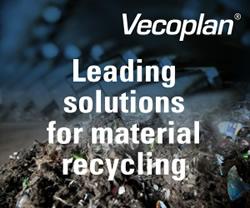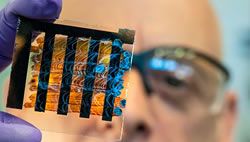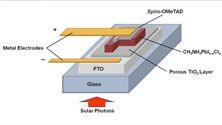Perovskite Solar Cells Taking the Heat
In a recently published Science paper, KAUST researchers have reported a significant milestone through the first-ever successful PV damp-heat test of PSCs.
NUS research team sets new efficiency record for solar cell technology
Their solar cells made using perovskite and organic materials achieve a power conversion efficiency of 23.6%, approaching that of conventional silicon solar cells
Can Perovskite Make Solar Power More Efficient?
The vast majority of solar panel semiconductors today consist mostly of silicon, which has limited efficiency. But in the past few years, a potential alternative has emerged. Perovskite.
How Governments Are Reducing Photovoltaic Tech Costs
New tech can gather data about energy distribution and storage, for instance. This step can further reduce costs as workers can store more energy on sunny days so it doesn't go to waste.
Solar Power is taking a step forward with PV Perovskite
The technology used in the innovative cells of Oxford PV consists of covering typical silicon solar cells with a thin perovskite material film for optimal use of photons in the solar spectrum.
Colorful Perovskites: NREL Advances Thermochromic Window Technologies
Scientists at the U.S. Department of Energy's National Renewable Energy Laboratory (NREL) report a breakthrough in developing a next-generation thermochromic window that not only reduces the need for air conditioning but simultaneously generates electricity.
NREL Research Boosts Stability of Perovskites, Helps Silicon Solar Cells
A change in chemical composition enabled scientists to boost the longevity and efficiency of a perovskite solar cell developed at the U.S. Department of Energy's (DOE's) National Renewable Energy Laboratory (NREL).
NREL Inks a Future for Perovskites
Moore, a staff scientist at NREL, is researching fast-drying solvents for the development of perovskite ink-a shortcut to the eventual commercialization of perovskite technologies.
Solar powered smart windows break 11% efficiency
John Fitzgerald Weaver for Electrek: The smart window lowers building temperatures by shifting from clear to opaque under strong sunlight. When the shift to opaque occurs, the solar prototype begins electricity production.
Are Perovskite Solar Cells in Our Future?
One challenge for perovskite commercialization is stability, as the light-sensitive material in these devices dissolves in the presence of water and decomposes at high temperature.
NREL's New Perovskite Ink Opens Window for Quality Cells
Proven highly efficient at converting sunlight into electricity, perovskite solar cells have yet to move beyond the laboratory.
Imec and Solliance's perovskite PV modules achieve 12.4%
Imec, the world-leading research and innovation hub in nanoelectronics, energy and digital technologies, and partner in Solliance today announced that they have improved their 4x4cm² perovskite module achieving a certified conversion efficiency of 12.4%, which is amongst the highest for this size of perovskite modules. The module efficiency was measured under long-term maximum power point (MPP) tracking, testifying to its exceptional stability. At Solliance, this perovskite technology is developed with industrially-applicable processes and with a view towards a rapid market introduction of this promising source of renewable energy.
NREL Research Pinpoints Promise of Polycrystalline Perovskites
With prior studies into perovskites focusing on bulk recombination, one area left unexamined until now concerned the surface recombination in lead iodide perovskites. NREL's scientists determined recombination in other parts of a methylammonium perovskite film isn't as important as what's happening on the surface, both the top and bottom.
Matthew Beard and his colleagues within NREL's Che
What is a Stacked Perovskite/CIGS Solar Module?
As this result shows that the combination of two PV technologies can outperform the power generation of single junctions the significance of this result shouldnt be underestimated as it breaks the current limitations of solar technology and shows that higher performing modules can be expected to become part of the energy system ... Tom Aernouts, imec
UH Researchers Discover Key Mechanism for Producing Solar Cells
Better Understanding of Perovskite Solar Cells Could Boost Widespread Use
Records 16 to 30 of 30
Featured Product

Vecoplan - Planning and implementation of complete processing plants in refuse derived fuel production
In order to reduce the costs involved in the energy-intensive production of cement, many manufacturers are turning to refuse-derived fuels (RDF), considerably reducing the proportion of expensive primary fuels they would normally use. Solid fuels are being increasingly used - these might be used tyres, waste wood or mixtures of plastics, paper, composite materials and textiles. Vecoplan provides operators of cement plants with proven and robust components for conveying the material and separating iron and impurities, efficient receiving stations, storage systems and, of course, efficient shredders for an output in various qualities.





.jpg)





